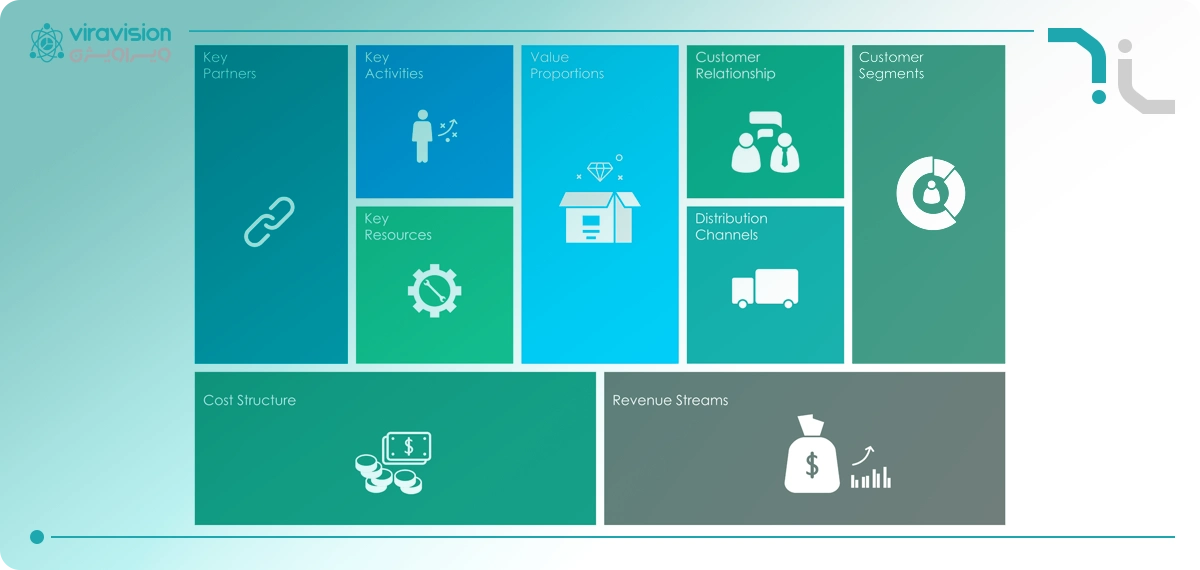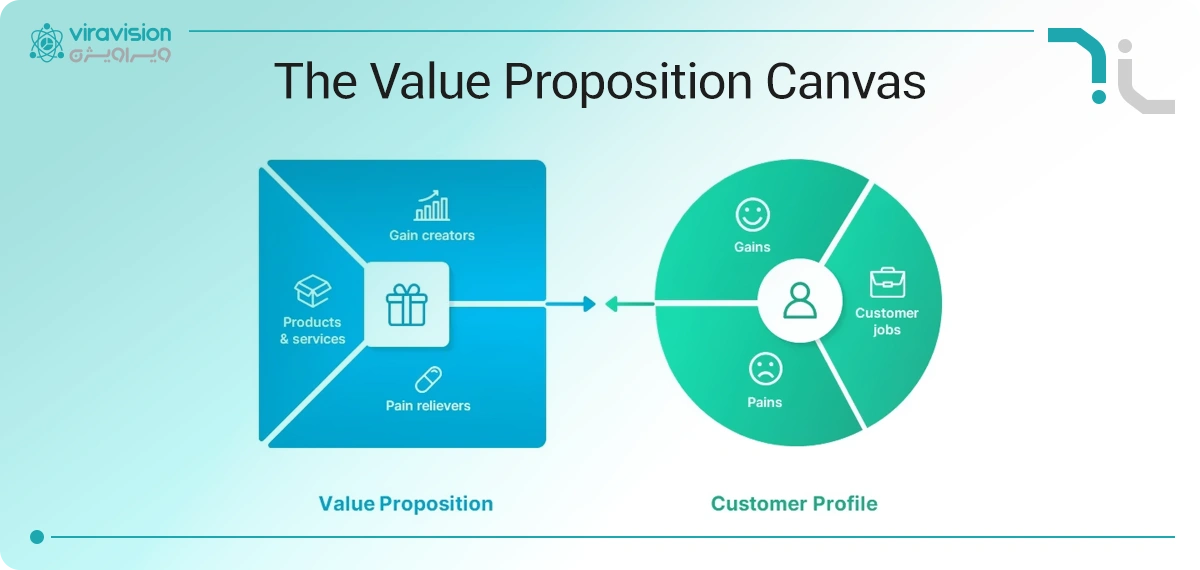The Business Model Canvas is a powerful tool for analyzing and designing business models, helping companies visually and coherently structure their activities. This canvas includes nine key components, each playing a vital role in a business’s success. A proper understanding of these components helps entrepreneurs identify their target market, offer unique value propositions, and adopt effective strategies for revenue generation and cost reduction.
For example, accurately defining customers and understanding their needs allows companies to design products and services tailored to the market. Additionally, choosing effective distribution channels, establishing sustainable customer relationships, and defining steady revenue streams are other critical parts of the Business Model Canvas.
Companies that properly analyze and implement these components are more likely to grow and compete in the market. Reviewing business model canvas examples from successful companies shows that focusing on these nine components directly impacts productivity, risk reduction, and financial performance. Therefore, familiarity with the Business Model Canvas and applying it in strategic planning can pave the way for success.

Difference Between a Business Model and a Business Model Canvas; Which Should You Choose?
The business model and the Business Model Canvas are two key concepts in the business world that are sometimes mistakenly used interchangeably. A business model defines the overall framework of a company’s activities, explaining how a business creates value, delivers it to customers, and generates revenue. It is usually prepared as a comprehensive document, including information about strategy, target market, financial resources, and cost structure.
In contrast, the Business Model Canvas is a visual and simpler tool to represent a business model, designed by Alexander Osterwalder. The canvas includes nine key components such as customers, value proposition, communication channels, revenue streams, and key resources, helping companies analyze their model concisely and efficiently. A main advantage of the Business Model Canvas is its flexibility and the ability to quickly explore different models.
Examples from successful companies show that this tool is particularly useful for startups and new businesses as it helps them understand the market better and quickly optimize strategies. Choosing between a full business model and a canvas depends on the company’s needs; for detailed and long-term analysis, a business model is preferable, whereas for fast and flexible design, the canvas is ideal.

1. Customer Segment; Precisely Identifying the Target Market
One of the most important components of the Business Model Canvas is the Customer Segment, which focuses on accurately identifying the target market. Every business must know which group of customers its products or services are intended for and understand their needs correctly.
Without accurate customer understanding, even the best business model can fail. Customers are categorized into segments such as mass, niche, multi-sided, or micro. For example, a tech company offering cloud services may target both large enterprise clients and small startups. Choosing the right target market ensures marketing and sales strategies are more effective.
Examples from successful companies show that they not only define their target market precisely but also use analytical data to study customer behavior and anticipate their needs. Using tools like customer behavior analytics and direct feedback helps optimize services and enhance user experience. Therefore, paying special attention to the Customer Segment can directly impact business growth and profitability.
2. Value Proposition; Why Should Customers Choose You?
The Value Proposition is one of the most critical components of the canvas, defining why customers should choose a business’s products or services. In today’s competitive world, having a good product is not enough; there must be a compelling reason why this product or service is superior to competitors.
A successful business model must deliver a unique value, which could include higher quality, better price, superior services, or a simpler user experience. For example, a tech company providing accounting software can differentiate its value proposition with features like system integrations and 24/7 support.
Examples from successful brands show that companies that clearly define their value proposition achieve higher customer acquisition and retention rates. The value proposition must directly address customer needs and problems, creating a unique and superior experience. Therefore, businesses should focus not only on product development but also on delivering a compelling and valuable proposition.

3. Channels; Best Ways to Reach Customers
In the canvas, communication and distribution channels play a key role in connecting the business to customers. This component specifies how products or services reach customers and how effective communication is maintained. Choosing the right channels can increase brand awareness, improve customer experience, and ultimately boost sales. Channels may be direct or indirect; for instance, an online business might use a website, social media, digital ads, and email marketing, while a physical store may use distributors, retailers, and in-person sales.
A successful business model typically combines online and offline channels for maximum reach. Examples show that proper channel selection improves conversion rates, turning potential customers into loyal ones. Companies should choose the best channels based on customer needs and product characteristics to ensure effective interaction and strengthen competitive advantage.

4. Customer Relationships; How to Retain Customers
Customer Relationships define how a business interacts with and retains its customers. Acquiring new customers is expensive and challenging, while retaining existing ones can be more profitable. A successful business model goes beyond sales, providing after-sales services, strong support, personalized offers, and loyalty programs to create valuable experiences. Companies using CRM systems can analyze customer behavior and provide tailored offers.
Examples show that continuous, effective communication via email, social media, phone calls, and online support increases customer trust and loyalty. Companies that value feedback and improve products based on it have higher retention rates. Therefore, optimizing communication strategies is essential for creating positive and sustainable customer interactions.
5. Revenue Streams; How the Business Makes Money
Revenue Streams indicate how a business earns money from its products or services. A sustainable business model requires clearly defined revenue streams as they determine profitability. Businesses can generate revenue through direct sales, subscriptions, advertising, service fees, membership models, or commissions. For example, an online educational platform may earn revenue from course sales, premium subscriptions, and advertising.
Diversifying revenue streams helps increase financial stability. Companies relying on a single source are more vulnerable to market changes. Therefore, modern businesses often implement a combination of revenue models, such as software companies using both license sales and subscription (SaaS) models.

6. Key Resources; Assets That Grow the Business
Key Resources show what assets a company needs to succeed and deliver its value proposition. These can be physical, financial, human, or intellectual resources. For example, a manufacturing company needs machinery and raw materials, while a tech startup relies on specialized personnel and software. Intellectual property, patents, and branding are key resources in knowledge-based businesses.
Investing in appropriate key resources is a primary factor in sustainable growth. Companies like Amazon and Apple focus heavily on proprietary technology and unique ecosystems. Proper management of key resources helps maintain competitive advantage and achieve market success.

7. Key Activities; Critical Actions for Company Success
Key Activities define the critical actions a company must perform to deliver value, retain customers, and generate revenue. These vary by business type. Manufacturing focuses on production, distribution, and quality control, while digital businesses focus on software development, digital marketing, and customer support. Properly defining key activities optimizes resources and supports sustainable growth.
Successful companies focus on the right activities. For example, Tesla emphasizes R&D, battery innovation, and efficient supply chains. Companies lacking clear key activities or focusing on unnecessary tasks risk failure. Defining, prioritizing, and optimizing key activities ensures maximum value for customers at minimal cost.

8. Key Partnerships; Collaborations That Drive Growth
Key Partnerships help companies access resources, markets, and expertise they cannot reach alone. Successful companies often collaborate with suppliers, distributors, business partners, or even competitors strategically. For example, tech companies collaborate with cloud providers or hardware manufacturers. Retail brands optimize supply chains through trusted suppliers.
Examples from Uber and Amazon show that partnerships improve productivity, reduce costs, and increase profitability. Uber, for instance, provides transport services through independent drivers without owning vehicles, reducing operational costs and enabling rapid scalability. Strategic collaborations are essential for sustainable business growth.
9. Cost Structure; Financial Management for Profitability
Cost Structure outlines the expenses a company incurs in operating its business model. These include salaries, production, marketing, technology, rent, taxes, and other operational costs. Proper cost management increases efficiency and profitability. Companies optimizing costs remain resilient against market fluctuations and can offer competitive prices.
Examples show that cost-reduction strategies without compromising quality contribute to sustainable growth. Brands like Walmart reduce supply chain costs and increase operational efficiency to offer competitive prices. Poor cost management can lead to financial problems or bankruptcy. Businesses must identify essential and non-essential costs, use technology to reduce expenses, and establish a sustainable financial model for long-term success.

Final Words
Ultimately, the Business Model Canvas is an essential tool for any business aiming to succeed in today’s competitive environment. It clarifies and optimizes key processes, allows strategic resource use, and supports sustainable growth. Carefully designing each component, from customer segments and value propositions to cost management and key partnerships, creates an efficient roadmap.
Companies should continuously review and update their canvas to remain flexible amid market changes and achieve long-term success. Especially in the digital era, where rapid changes and continuous innovation are inevitable, having a comprehensive and precise Business Model Canvas can determine a business’s success or failure. Using sample canvases for strategic planning enhances decision-making clarity and ensures sustainable growth.